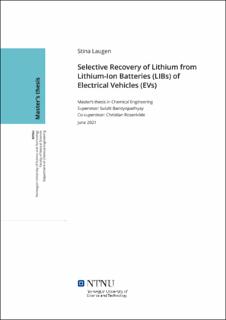| dc.description.abstract | Lithium-ion batteries (LIBs) dominate in the electric vehicle (EV) market due to their excellent performance. The recent growth is primarily driven by the electrification of transportation. Despite a recession in overall sales due to the covid-19 pandemic, an increase of 137% from 2020-2021 exhibits a sensational success in the global sales of EVs. This growing global demand for electric vehicles increases the necessity for circularity in terms of recycling. Furthermore, it is predicted that the future market of LIBs will primarily be constrained by the supply of raw materials – especially in the power storage segment.
Europe is approaching a challenge with waste management as the first generation of LIBs is expected to reach their end of life in the very near future. To be ahead of time and be able to efficiently manage the expected volume of both waste and to effectively manage recycling requirements, an infrastructure needs to be established urgently.
The overall goal for the LIBRES project is to develop a pilot plant to treat the Norwegian volume of EOL LIBs by 2025. The goal must be in conjunction to criteria of cost efficiency and reduced environmental impacts. Employing a hydrometallurgical approach will redeem the requirements and furthermore encounter the goal of high recovery rates. This work aims to selectively recover lithium in the context of resource savings and meeting demands for the increasing EV market, as a part of the LIBRES project.
Selective lithium recovery from spent LIBs of EVs using oxalic acid and chemical precipitation was investigated. The black mass was dissolved by inorganic and organic acid. The leaching was followed by removal of impurities and selective Li recovery through precipitation.
The results demonstrate that sulfuric acid in the presence of a reducing agent aided the efficiency and provide efficiencies in the range of 83-100% for the different metals. Selective lithium dissolution was succeeded using oxalic acid, maximum efficiency of 63% was achieved with an s/l-ratio of 30 g/L and 53˚C. The use of organic acid generated an additional step to recover the remaining metals, and the subsequent inorganic acid leaching yielded lower efficiencies (-83%, -40%, and -16% for Ni, Co, and Mn, respectively) compared to the one of the initial black mass directly. Recovery of solid lithium in the form of Li2CO3 was insufficient, considering the 16% efficiency. However, treating anode and cathode together will contribute to the goal of increased automation. Additionally, it will decrease operational costs.
KEYWORDS: Electrical Vehicles, LIB, Recycling, Hydrometallurgy, Oxalic acid, Li recovery | |
